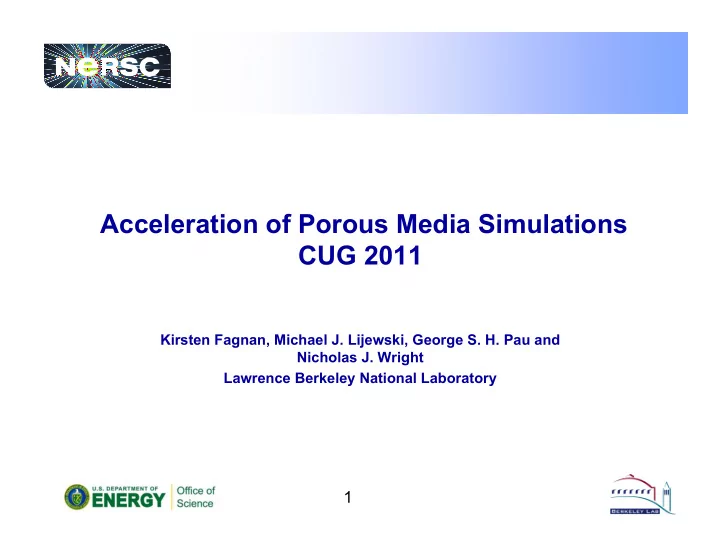

Acceleration of Porous Media Simulations CUG 2011 Kirsten Fagnan, Michael J. Lijewski, George S. H. Pau and Nicholas J. Wright Lawrence Berkeley National Laboratory 1
Outline • Background on Porous Media, why are we interested in this problem • Mathematical Model • Computational Approach • How long will it take to simulate out to 25 years? • Summary and conclusions 2
Motivation • Fluid flow with chemical reactions in a porous material is found in a variety of geophysical processes, e.g. – Carbon sequestration Courtesy ¡of: ¡ h-p://blog.aapg.org/geodc/wp-‑content/uploads/2008/12/carbon-‑sequestra?on.gif ¡ Calculation done by George Pau (LBNL) with PMAMR 3
Motivation • The DOE is also interested in modeling groundwater contamination This shows the progression of underground contaminants (Uranium!) at the F-basin site From the ASCEM demo document, 2010 4
Motivation • The DOE is also interested in modeling groundwater contamination Cartoon schematic of the computational domain of interest that we approximate in our calculations From the ASCEM demo document, 2010 5
Mathematical Model • Equations of Interest 6
Mathematical Model (PDE types) • Equations of interest Parabolic! Hyperbolic! Elliptic! 7
Computational Model • Implicit-pressure Explicit-saturation (IMPES) approach – Parabolic pressure terms are solved with an implicit multigrid solver => All-to-All communication across MPI tasks – Hyperbolic terms are solved with an explicit method (2 nd order Godunov-type method) => only requires communication in ghost cells 8
Adaptive Mesh Refinement Allows us to use fine grids only around important spatial features (we use Berger-Oliger style AMR). Figure: 2D calculation of fingering present Figure: Load balancing is achieved in carbon sequestration – illustrates the through the use of a space-filling use of AMR on Cartesian grids curve 9
Chemistry Solver – ASCEM project • The geochemistry solver that models the interaction of reactants present in the fluid is called point-by-point with data local to each computational grid cell. 10
How long will it take to simulate out to 25 years? • Current time step restriction on a grid used to resolve the finest spatial scales of the groundwater contaminant problem: dt ~ 300 seconds • 25 years/dt ~2,628,000 computational steps! • Note: implicit methods do not face the same time-step restriction, but fail to resolve the front of the plume due to numerical dissipation 11
How can we speed this up? • BoxLib is already parallelized with OpenMP and MPI, a legacy code that is fairly well optimized. (scaling plot without chemistry) • Profiling of the code indicated that more than 40% percent of the time was being spent in the ASCEM chemistry solver. 12
OpenMP for Porous Media • AMR is ‘hard’ to load balance – Minimize the number of MPI tasks • Chemistry is embarrassingly parallel – Takes 40% of runtime* • Hopper has 24 cores per node and less memory than Franklin • This implies that we should use OpenMP to speed things up 13
Chemistry+Hopper => OpenMP • The chemistry solves were already being spread out across MPI tasks • The structure of Hopper made threading a logical option – embarassingly parallel, but chemistry solver was not threaded or optimized 14
Chemistry code was not optimized! • When we initially ran the threaded code, it was slower. More threads => longer run time • We explored the chemistry solver we were using and found that there were several issues – passing large arrays by value, lots of exceptions and no optimization flags for the compiler • Optimization of this code meant that the chemistry was reduced to %20 of the runt time 15
System Simulated • Problem size: nx=128 ny=128 nz = 128, max grid 64^3 • 2 levels of refinement • 32 chemical species – Grids are distributed based on the difficulty of the chemistry solve 16
Chemistry Speedup 17
MPI vs. MPI/OpenMP At 128 nodes MPI+OpenMP starts to outperform MPI-only 18
How long to simulate 25 years of a realistic problem At best it would still take more than a year! 19
Things you may find interesting • PGI compiler fails to work with threaded C++ code that passes arrays by value instead of by reference (show plot demonstrating that it takes longer with threads) • This is not good software design, but it only failed to work when using PGI • Bug submitted to the PGI compiler group 20
Summary • We need to simulate out to 25 computational years in order to produce meaningful results • MPI alone provides insufficient speed-up when modeling large chemical systems • The introduction of OpenMP allows us to calculate to 25 years in roughly half the time of MPI alone, but it’s still not fast enough • Chemistry solves are now extremely fast, but Multigrid is proving to be the next bottleneck • We are also working on an algorithmic approach that would allow us to take longer time steps 21
Acknowledgements • DOE ARRA funding • George Pau, Michael Lijewski and Nicholas Wright • John Shalf, John Bell and Alice Koniges 22
Recommend
More recommend